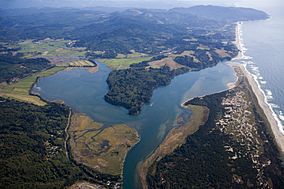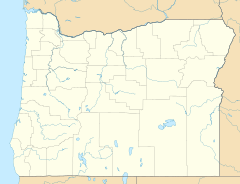Nestucca Bay National Wildlife Refuge facts for kids
Quick facts for kids Nestucca Bay National Wildlife Refuge |
|
|---|---|
|
IUCN Category IV (Habitat/Species Management Area)
|
|

Aerial view of the refuge
|
|
| Location | Tillamook County, Oregon |
| Nearest city | Tillamook |
| Area | 888 acres (359 ha) |
| Governing body | U.S. Fish and Wildlife Service |
| Website | Nestucca Bay NWR |
Nestucca Bay National Wildlife Refuge is a special protected area for animals and plants on Oregon's coast. It is located in southern Tillamook County. This refuge is one of six National Wildlife Refuges that make up the Oregon Coast National Wildlife Refuge Complex. It is very important because it provides a home for about one-tenth of all the dusky Canada geese in the world!
The refuge has many different types of natural homes, called habitats. These include areas where the ocean tides come in and out, like tidal marshes and mudflats. There are also grasslands, forests, and bogs. A bog is a wet, spongy area of land, often with special plants like mosses. The Nestucca Bay Refuge has the most southern Sphagnum bog habitat along the Pacific Coast.
Contents
Amazing Plants and Animals
The Sphagnum bog habitat at Nestucca Bay is home to many unique plants and animals.
Unique Bog Plants
You can find some really cool plants here, like the insect-eating sundew plant. Sundews have sticky leaves that trap insects for food! You might also spot bog cranberry plants growing in this wet environment.
Ocean's Past: Tsunami Clues
Scientists have studied the ground under Neskowin Marsh, which is part of the refuge. They found many layers of sand and peat (partially decayed plant matter). These layers show a long history of tsunamis. A tsunami is a giant ocean wave often caused by underwater earthquakes. The sand layers were carried from coastal sand dunes by these powerful waves. These layers might be the best record of tsunami activity in the Cascadia subduction zone. This zone is where two of Earth's large plates meet and slide under each other, which can cause earthquakes and tsunamis.
Birds and Fish of the Refuge
The Nestucca Bay and River system is a vital home for many types of fish. These include Chinook and coho salmon, coastal cutthroat trout, and steelhead trout.
From November to April, the refuge's short grassy areas are a winter home for the dusky Canada goose and the Aleutian cackling goose. Many other birds also visit, such as migrating shorebirds, fast-flying peregrine falcons, and majestic bald eagles.
Where is the Refuge?
The Nestucca Bay National Wildlife Refuge was created in 1991. It is located on Nestucca Bay, where the Nestucca and Little Nestucca rivers meet. The refuge is about 3 to 5 miles (5 to 8 km) south of Pacific City. If you look across the bay to the west, you can see Nestucca Spit and Robert W. Straub state parks.
Visiting the Refuge
The refuge is usually closed to the public to protect the wildlife. However, there are two special events each year, one in February and one in October, when visitors can explore. A special viewing area is also planned for the future, which will allow people to observe the wildlife without disturbing it.



